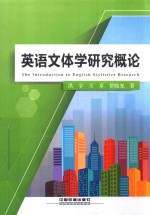

英语文体学研究概论PDF电子书下载
- 电子书积分:9 积分如何计算积分?
- 作 者:洪宇,王卓,贺晓光著
- 出 版 社:北京:中国铁道出版社
- 出版年份:2016
- ISBN:9787113227029
- 页数:162 页
Chapter 1 General Introduction 1
1.1 Definition of Style 1
1.1.1 Language 1
1.1.2 Style 2
1.2 Definition of Stylistics 4
1.3 Development of Modern Stylistics 8
Chapter 2 General Theories of Stylistics 10
2.1 Types of Stylistic Theories 10
2.1.1 Formal Stylistics 11
2.1.2 Functional Stylistics 12
2.1.3 Discourse/Text Stylistics 14
2.2 Models of Stylistics 15
2.2.1 The Sketch of Modern Linguistics 15
2.2.2 Models of Linguistic Stylistics 19
2.3 Three Views on Style 29
2.3.1 Style as Deviance 30
2.3.2 Style as Choice 32
2.3.3 Style as Foregrounding 34
Chapter 3 Grammar and Literary Style 37
3.1 Introduction 37
3.2 Definition of Grammar 38
3.3 Prescription and Description 39
3.4 Morphology and Syntax 40
3.5 Word Classes 43
3.5.1 Identifying Word Classes 44
3.5.2 Open and Closed Class Words 46
3.6 Describing Noun and Verb Phrases 47
3.6.1 The Noun Phrase 48
3.6.2 The Verb Phrase 49
3.6.3 Non-finite Verb Phrases 50
3.7 Describing Sentences 52
3.7.1 Sentences and Clauses 52
3.7.2 Simple and Complex Sentences 53
3.8 Foregrounding and Grammatical Form 56
3.9 Analysis of Grammar:Checklist 59
Chapter 4 Meaning 61
4.1 Introduction 61
4.2 Semantics 61
4.2.1 Gaps and Overlaps 62
4.2.2 Opposites 63
4.2.3 Hyponyms and Superordinates 64
4.3 Context 65
4.3.1 Deixis 66
4.3.2 Homonyms 67
4.3.3 Other Similar Texts/Discourses 67
4.3.4 Prior Knowledge 68
4.4 Register 69
4.5 Literal Language and Figurative Language 71
4.5.1 Similes 72
4.5.2 Metaphor 72
4.5.3 Simile versus Metaphor 74
4.5.4 Explicit and Embedded Metaphors 75
4.5.5 Types of Metaphor 77
4.5.6 Metonymy 82
4.5.7 Synecdoche 82
4.6 Metaphor and Language Change 83
4.7 Functions of Figurative Language Use 84
Chapter 5 International Business 85
5.1 Semantic Features 85
5.1.1 Correctness and Completeness 85
5.1.2 Clearness and Conciseness 86
5.1.3 Consideration and Courtesy 87
5.2 Grammatical Features 87
5.2.1 B Sentence Structure 87
5.2.2 Use of Voices 88
5.2.3 Use of Affirmative Sentences 89
5.2.4 Inverted Sentences 89
5.3 Lexical Features 89
5.3.1 Concrete and Natural Words 89
5.3.2 Technical Terms and Abbreviations 90
5.3.3 Brief and Common Words 90
5.3.4 Avoiding Clichés 91
5.4 Graphological Features 92
5.4.1 Capitalization 92
5.4.2 Arrangement of Typesetting 92
Chapter 6 Computer and Internet 95
6.1 Computer Language 95
6.1.1 Lexical Features 96
6.1.2 Grammatical Features 98
6.2 Internet Language 99
6.2.1 Semantic Features 100
6.2.2 Grammatical Features 101
6.2.3 Lexical Features 102
6.2.4 Graphological Features 107
Chapter 7 The English of Conversation 110
7.1 Necessity of Studying Speech 110
7.2 Necessity of Studying Conversation 110
7.3 Object of Study 110
7.4 An Adapted Way of Transcription 111
7.5 General Features 111
7.6 Stylistic Features in Terms of Levels of Language 113
7.6.1 Grammatical Features 113
7.6.2 Lexical Features 115
7.6.3 Phonological Features 118
7.6.4 Semantic Features 119
7.7 Summary & Other Kinds of Conversation 120
7.8 Discussion about Telephone Conversing 120
Chapter 8 News Report 121
8.1 Semantic Features 122
8.2 Text Structure 122
8.2.1 Headline 123
8.2.2 Guide 125
8.2.3 Main Body 126
8.3 Grammatical Features 129
8.3.1 Meaning Contraction 129
8.3.2 Objectivity 130
8.3.3 Concreteness and Detailedness 130
8.4 Lexical Features 131
8.5 Graphological Features 131
Chapter 9 The English of Public Speech 133
9.1 Scope of Public Speech 133
9.2 A Sample Text for Analysis 133
9.3 General Features of Public Speech 135
9.4 Stylistic Features of Public Speech 135
9.4.1 Grammatical Features 135
9.4.2 Lexical Features 137
9.4.3 Phonological Features 138
9.4.4 Semantic Features 140
Chapter 10 Legal Documents 144
10.1 Function and Style 144
10.2 Grammatical Features 145
10.2.1 Basic Sentence Structure and Process Types 145
10.2.2 Verbal Groups 145
10.2.3 Noun Phrases or Participants 146
10.2.4 Adverbials 147
10.2.5 The Sentence 147
10.3 Lexical Features 148
10.3.1 Sources 148
10.3.2 Classifications and Functions 148
10.4 Graphological Features 149
10.4.1 Punctuation 149
10.4.2 Capitalization 150
10.4.3 The Marking of Text Structures 150
Chapter 11 Science and Technology 151
11.1 Semantic Features 151
11.1.1 The Explicitness of the Relations between Semantic Structures 152
11.1.2 Depersonalization 152
11.1.3 Renationalization 154
11.2 Grammatical Features 155
11.3 Lexical Features 157
11.3.1 Sources 157
11.3.2 Classification 158
11.3.3 Function 158
Bibliography 160
- 《红色旅游的社会效应研究》吴春焕著 2019
- 《汉语词汇知识与习得研究》邢红兵主编 2019
- 《生物质甘油共气化制氢基础研究》赵丽霞 2019
- 《东北民歌文化研究及艺术探析》(中国)杨清波 2019
- 《联吡啶基钌光敏染料的结构与性能的理论研究》李明霞 2019
- 《全国高等中医药行业“十三五”创新教材 中医药学概论》翟华强 2019
- 《异质性条件下技术创新最优市场结构研究 以中国高技术产业为例》千慧雄 2019
- 《《国语》和《战国策》词汇比较研究》陈长书著 2017
- 《中国制造业绿色供应链发展研究报告》中国电子信息产业发展研究院 2019
- 《行政保留研究》门中敬著 2019
- 《中风偏瘫 脑萎缩 痴呆 最新治疗原则与方法》孙作东著 2004
- 《水面舰艇编队作战运筹分析》谭安胜著 2009
- 《王蒙文集 新版 35 评点《红楼梦》 上》王蒙著 2020
- 《TED说话的力量 世界优秀演讲者的口才秘诀》(坦桑)阿卡什·P.卡里亚著 2019
- 《燕堂夜话》蒋忠和著 2019
- 《经久》静水边著 2019
- 《魔法销售台词》(美)埃尔默·惠勒著 2019
- 《微表情密码》(波)卡西亚·韦佐夫斯基,(波)帕特里克·韦佐夫斯基著 2019
- 《看书琐记与作文秘诀》鲁迅著 2019
- 《酒国》莫言著 2019
- 《中国当代乡土小说文库 本乡本土》(中国)刘玉堂 2019
- 《异质性条件下技术创新最优市场结构研究 以中国高技术产业为例》千慧雄 2019
- 《中国铁路人 第三届现实主义网络文学征文大赛一等奖》恒传录著 2019
- 《莼江曲谱 2 中国昆曲博物馆藏稀见昆剧手抄曲谱汇编之一》郭腊梅主编;孙伊婷副主编;孙文明,孙伊婷编委;中国昆曲博物馆编 2018
- 《中国制造业绿色供应链发展研究报告》中国电子信息产业发展研究院 2019
- 《中国陈设艺术史》赵囡囡著 2019
- 《指向核心素养 北京十一学校名师教学设计 英语 七年级 上 配人教版》周志英总主编 2019
- 《《走近科学》精选丛书 中国UFO悬案调查》郭之文 2019
- 《清至民国中国西北戏剧经典唱段汇辑 第8卷》孔令纪 2018
- 《北京生态环境保护》《北京环境保护丛书》编委会编著 2018
